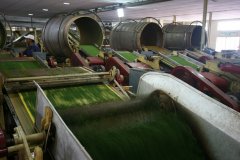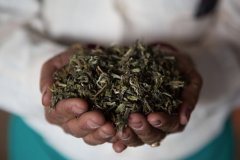The grading standard and classification of black tea what is the meaning of FOP and BOP in black tea which grade is higher?
Many delicious friends who taste black tea want to get a kind of black tea quickly, but when they open some orange software and want to chop an order, they all want to buy the top tea, but find that the grade of tea is big.
What is BOP? What is FBOP? This STGFOP looks so awesome. Does it mean top class?
Really dazzling, impatient, directly from entry to give up, after seeing the level of this string of letters, the idea of buying tea was instantly discouraged.
Next, let's talk about the classification of tea in detail.
What is the difference in the quality of each grade of tea?
We usually talk about OP, BOP and other words, here refers to the tea according to the size and size of the classification. Think about it, the potato chips you bought in the supermarket are big and small, and they end up full of dregs, which is very uncomfortable. But if it is tea, a big one and a small one, the extraction will be uneven, the extraction of the leaflet is excessive, and the taste of the big leaf has not come out yet.
So the Grading here is to make each package of tea uniform, not a difference in quality.
At present, the size of the traditional method is divided into: OP, BOP, BOPF, F and D.
None of these sizes and shapes have established the agreed specifications, and because the sieve used by each tea factory is of different size, there is a slight difference in the thickness and length of the screen. However, the tea factories have a consensus on the grade name, length, size and thickness.

[OP]
OP,Orange Pekoe, orange and white hairs. OP grade tea, its tea soup color is quite high transparency of light orange, so it is called "orange". In addition, when the tea is injected into the teacup, you can see that the surface of black tea will float fine fibers like cotton shavings. This is "Bai Hao". This kind of Bai Hao is actually the fetal hair covered on the surface of the new tea buds. It is the emergence of Bai Hao that shows that there are more new buds used in this batch of tea, and the new buds will not be chopped up, but mixed into the tea in a complete form.
Op tea is generally about 1 to 2 centimeters long, which is the largest kind of tea. Common OP black teas are Darjeeling in India and Qimen in China.
[BOP]
B stands for BROKEN. After grading, when the size of the tea is 2 to 3 mm, it belongs to BOP.
The aroma and astringency of black tea will be related to the producing area, planting altitude, season, climate and other factors.
The tea with strong astringency is suitable for op type, which slows down the astringency through slow extraction and leads to the unique freshness of black tea.
However, if the astringency in the tea is in the middle, or if you want to extract a strong aroma or taste in a short time, the leaves must be processed into a fine and small shape. Only in this way can the results of extraction be enhanced.
After the kneading process is completed, a kneading and cutting machine is used to cut the tea into 2-3 mm BOP type tea. The tea produced in Sri Lanka is usually BOP.

[BOPF]
F stands for FANNINGS. In the BOP type of tea further screening to select 1 mm of tea, that is, BOPF type.
BOP and BOPF are only used to show the size, but the BOPF type contains many new buds, which is of better quality, so it is usually regarded as first-class tea.
BOPF tastes more astringent and mellow than BOP.
[F]
Fleming Fannings, slices of tea, finely chopped tea about 1 mm in size, sifted out from BOP. This kind of tea has fast extraction speed and strong astringent taste, so it is suitable for brewing milk tea or making tea bags.
[D]
Dame Dust, tea powder. This grade of tea can pass through the bottom of the mesh and then fall fine-grained tea. The black tea of this shape has a solid flavor, with a strong sour taste and strong taste, and is mainly used to make tea bags.
Classification of traditional black tea
The traditional method of making tea is slightly divided into four types according to the shape of tea: original slices (WHOLE LEAF), finely cut leaves (BROKEN LEAF), slices of tea (FANNINGS), and powdered tea powder (DUST).
[WHOLE LEAF]
TGFOP, Tippy Golden Flowery Orange Pekoe
FOP 1, Flowery Orange Pekoe One
FOP, Flowery Orange Pekoe
OP, Orange Pekoe
[BROKEN LEAF]
FBOP, Flowery Broken Orange Pekoe
BOP 1, Broken Orange Pekoe One
BOP, Broken Orange Pekoe
[FANNINGS]
BOPF, Broken Orange Pekoe Fannings
F, Fannings
[DUST]
D 1, Dust One
D, Dust
Important Notice :
前街咖啡 FrontStreet Coffee has moved to new addredd:
FrontStreet Coffee Address: 315,Donghua East Road,GuangZhou
Tel:020 38364473
- Prev

CTC black tea and BOP black tea which is better? CTC black tea production process detailed explanation
Black tea, inadvertently invented in the making of oolong tea. Later, with the arrival of the Great Maritime Age, black tea went to the more distant western world. Later, the popularity of black tea became more and more widespread, from imperial relatives to ordinary people, drinking a cup of black tea every day. However, the demand is so large, manual operation, how can we meet everyone's needs
- Next

What's the difference between black tea and pure tea? which one is better?
As we all know, tea from different producing areas has its own characteristics. Sometimes, some senior tea lovers will mix tea from different producing areas to get mixed tea with better flavor in order to seek a more comprehensive flavor. However, before we discuss mixed tea, we need to know the original tea. What is original tea? The leaves after harvesting in the tea garden have gone through more than a dozen.
Related
- Beginners will see the "Coffee pull flower" guide!
- What is the difference between ice blog purified milk and ordinary milk coffee?
- Why is the Philippines the largest producer of crops in Liberia?
- For coffee extraction, should the fine powder be retained?
- How does extracted espresso fill pressed powder? How much strength does it take to press the powder?
- How to make jasmine cold extract coffee? Is the jasmine + latte good?
- Will this little toy really make the coffee taste better? How does Lily Drip affect coffee extraction?
- Will the action of slapping the filter cup also affect coffee extraction?
- What's the difference between powder-to-water ratio and powder-to-liquid ratio?
- What is the Ethiopian local species? What does it have to do with Heirloom native species?

